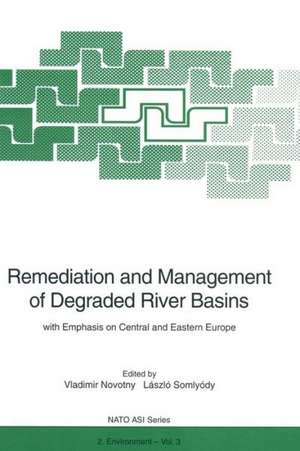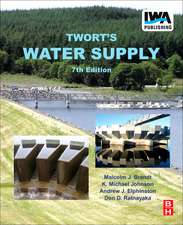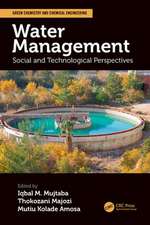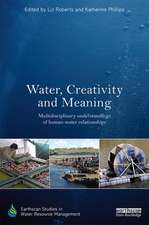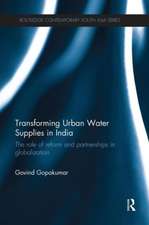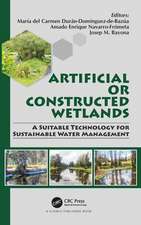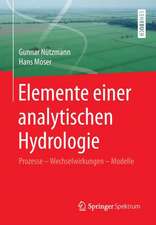Remediation and Management of Degraded River Basins: with Emphasis on Central and Eastern Europe: Nato Science Partnership Subseries: 2, cartea 3
Editat de Vladimir Novotny, Laszlo Somlyodyen Limba Engleză Paperback – 28 oct 2012
Preț: 402.56 lei
Nou
Puncte Express: 604
Preț estimativ în valută:
77.05€ • 80.14$ • 64.57£
77.05€ • 80.14$ • 64.57£
Carte tipărită la comandă
Livrare economică 13-27 martie
Preluare comenzi: 021 569.72.76
Specificații
ISBN-13: 9783642633461
ISBN-10: 3642633463
Pagini: 548
Ilustrații: XI, 530 p.
Dimensiuni: 155 x 235 x 35 mm
Greutate: 0.76 kg
Ediția:Softcover reprint of the original 1st ed. 1995
Editura: Springer Berlin, Heidelberg
Colecția Springer
Seria Nato Science Partnership Subseries: 2
Locul publicării:Berlin, Heidelberg, Germany
ISBN-10: 3642633463
Pagini: 548
Ilustrații: XI, 530 p.
Dimensiuni: 155 x 235 x 35 mm
Greutate: 0.76 kg
Ediția:Softcover reprint of the original 1st ed. 1995
Editura: Springer Berlin, Heidelberg
Colecția Springer
Seria Nato Science Partnership Subseries: 2
Locul publicării:Berlin, Heidelberg, Germany
Public țintă
ResearchCuprins
Content.- 1 Water Quality Management: Western Experiences and Challenges for Central and Eastern European Countries.- 1. Introduction and Background.- 2. Pollution Control Imperatives.- 3. Standards For Pollution Control.- 4. Water Pollution Control In The U.S..- 5. Challenges To Cee Countries.- 6. Institutions.- 7. Closing Remarks.- References.- 2 Use of Water Quality Models.- 1. Why and When Water Quality Modeling Is Needed.- 2. The Waste Load Allocation Process.- 3. Water Quality Models and Their Application.- 4. Selection and Application Criteria For Water Flow And Quality Models.- 5. Modeling Scenarios In The Wla (Tmdl) Processes.- References.- 3 Models for Reservoirs, Lakes and Wetlands.- 1. Introduction.- 2. Eco-Technological Aspects Of Watershed Management.- 3. Mathematical Models For Reservoir Water Quality Management.- 4. Model Categorization According To Water Quality Problems and Management Options For Their Solution.- 5. Models For Pollution Sources.- 6. Models For Pollution Consequences For Lakes And Reservoirs.- 7. Watershed Management Alternatives.- 8. Models For In-Lake and In-Reservoir Management Alternatives.- 9. Models For Quality Management Of Reservoir Outflow Water.- 10. Models For Prediction Of The Effect Of An Impoundment On Water Quality Of Its Outflow.- 11. Wetland Management Models.- 12. Integrated (Real Time) Management Of A Lake, Reservoir Or Wetland.- 13. Research Needs For Ecotechnological Water Quality Models.- 14. Conclusions.- References.- 4 Modeling Toxic Contaminants in an Aquatic Environment.- 1. Use Of Toxic Substance Models.- 2. Important Processes For Contaminants In An Aquatic Ecosystem.- 3. Characteristic Features and Classification Of Ecotoxicological Models.- 4. An Overview Of Toxic Substance Models For Aquatic Overview.- 5.A Case Study: A Mercury Model For Mex Bay, Alexandria (Egypt).- 6. Summary and Conclusions.- References.- 5 Sediment Toxicity and Equilibrium Partitioning Development of Sediment Quality Criteria for Toxic Substances.- 1. Introduction.- 2. Toxicity and Bioavailability Of Nonionic Organic Chemicals In Sediments.- 3. Toxicity and Bioavailability Of Metals In Sediments.- References.- 6 Contaminated Sediments and Remediation-Geochemical Perspective.- 1. Introduction.- 2. Identification Of Sources and Temporal Developments.- 3. Sediment Quality Criteria.- 4. Remediation Procedures For Dredged Sediments.- References.- 7 Assessment and Impact of Large Scale Metal Polluted Sites.- 1. Introduction.- 2. Capacity and Intensity Controlling Parameters.- 3. Case Studies.- References.- 8 Groundwater Remediation and Modeling.- 1. Introduction.- 2. Groundwater Contamination.- 3. Groundwater Remediation.- 4. Groundwater Modeling.- 5. Modeling Case Studies.- References.- Appendix: Sources For Computer Programs.- 9 Wastewater Treatment Technology, Economy and Politics.- 1. Introduction.- 2. Regulatory Issues.- 3. Less Expensive Technologies.- 4. Conclusions.- References.- Appendix 1.- 10 Wastewater Treatment Process Development in Central and Eastern Europe-Strategies for a Stepwise Development Involving Chemical And Biological Treatment.- 1. Introduction.- 2. Wastewater Management.- 3. Wastewater Treatment Methods For Eastern and Central Europe.- 4. Selection Of Local Wastewater Treatment Strategy.- 5. Economy.- 6. Step-Wise Development Of Wastewater Treatment Plants.- 7. Discussion.- 8. Conclusions.- 9. Summary.- References.- 11 Factors Affecting Water Quality of (Large) Rivers-Past Experiences and Future Outlook.- I: Present Views and State-of-the-Art.- 1. Introduction.- 2. Present View-The Situation Of The River Neckar and Its Relevance For Other River Systems.- 3. Future Outlook-Which Factors Are Still Relevant And Which Have Emerged As New?.- 4. Conclusions-What Developments Have Already Begun Today And What Is To Be Done Tomorrow.- References.- II: Future Outlook.- 1. Introduction.- 2. Increase Of Future Knowledge By Model Application Or Scientific Research.- References.- 12 River Basin Water Quality Management Strategies in the Central European Region: An Example of the Nitra River (Slovakia).- 1. Introduction.- 2. Emissions and Water Quality Situation In The Nitra River Basin.- 3. Modeling Effort.- 4. Municipal Waste Water Treatment Alternatives.- 5. Water Quality Control Policies.- 6. The Impact Of The Model Uncertainties On The Selection Of Control Strategies: Regret Analysis Approach.- 7. The Impact Of The Model Uncertainties On The Selection Of Control Strategies: A Posteriori Monte Carlo Simulation.- 8. Policy Recommendations.- 9. Conclusions.- References.- 13 The State of the Art in Economic Instruments and Institutions for Water Quality Management.- 1. Introduction.- 2. First Principles.- 3. Economic Instruments: Efficiency and Equity Properties.- 4. The Instruments.- 5. Economic Instruments Evaluated: Conceptual Issues And Practical Experience.- 6. Cross Cutting Themes In Incentive-Based Approaches To Water Quality Management.- 7. The Evolving Institutional Context.- 8. Conclusions and Research Implications.- References.- 14 Use of Economic Instruments to Enhance Cee Water Quality: Institutional Changes and Research Challenges.- 1. Introduction.- 2. Policy Pfsearch To Date.- 3. Application In The Oecd.- 4. Recent Developments.- 5. Cee Institutional Trends.- 6. Research Possibilities.- References.- 15 Summary and Conclusions.- 1. SummaryOf Workshop Presentations.- 2. Conclusions and Recommendations.- List Of Participants and Speakers.
